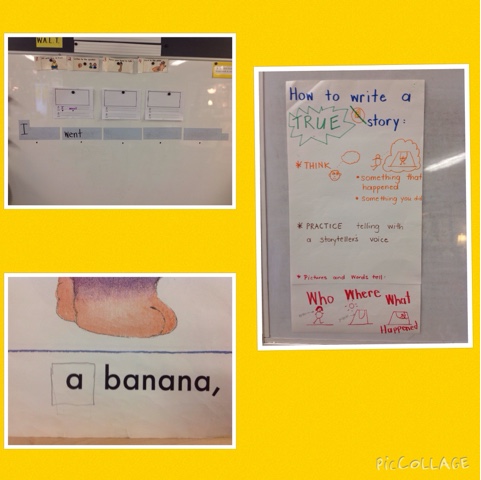A balanced literacy program combines a multitude of experiences
for children within a structure of four main components: Reading Workshop, Writing Workshop, Word Work and Read Aloud.
For Writing Workshop I primarily use the work of Lucy
Calkins, founding director of the Teachers College Reading and Writing Project
at Teachers College (Columbia University) to immerse ourselves in writing
instruction. Although I have been using her research to teach
writing for many years, over the last two summers I was fortunate enough to
study her latest work more in depth through my own graduate studies. Launching
Writing Workshop this year has been a very rewarding experience for me and I
cannot wait to share with parents how much their children have learned. I
began the first week of school. In the first three days of school I had
all students write independently to capture on paper what they knew and provide
a starting point from where they will grew as writers.
My first goal for writing is to develop each child's identity as a writer and surround them
with the work of being writers. This
can seem like an impossible undertaking for young children, but with
instruction that is developmentally appropriate, even kindergarteners can begin
to identify themselves as writers who have something important to say.
All year our class will be immersed in learning to use the same
tools all “published” writers use to put their ideas on a page.
Our first unit of study builds the foundational skills children
will use all year as we learn to write for a purpose. Behind
the lessons are some core beliefs about what writers do. For
example, writers write to put meaning onto paper. They start with
something to say and do everything they can to put that meaning on paper for an
audience of readers including stories, opinions, and thoughts. Writers
write about subjects that are important to them and so students also choose
their own topics most of the time. Writing starts with having an
image and then drawing representationally to put that meaning on paper. Writers
then pause and ask themselves if they need to add anything else to show their
mental image or intended meaning. In this way, we learn to use our
first “anchor” chart that reminds children that, “When we are done, we
have just begun.” This chart references how they continue to
convey their meaning by “adding pictures, adding word, or starting a new piece.” As
children develop skills around writing letter sounds in words, they learn to
stretch out, listen to and record all the sounds they hear in a word. In
time students will learn other mechanics writing including spaces between
words, uppercase letters at the beginning of a sentence and punctuation marks. For
now, we are immersed in putting ideas on paper with pictures and words.
I must say I am brilliantly
pleased with what your children have done in such a short time span to see
themselves as writers and carrying on as independently as they can with bravery
and confidence. They are learning to use the tools of self-reliance when
they have a problem, reminding themselves to say, “I can solve this problem
myself” when they get stuck. I love when they can look inward for help
before 20 of them all call my name! As we say “no, writers carry on with
writing and think how can I solve this problem by myself” while Mrs. B. is
conferencing with someone else. When writing time is done we often end
the workshop with a share by a few students. This builds self-confidence
and helps others to learn from their work. As children share, I point out
strategies they used so that others can use them, too. You should see the
smiles on writer’s faces when they are the reader of their writing and their
classmates acknowledge their work!
Each day’s lesson brings new learning along with links to previous
lessons. I use “anchor charts” to list
strategies we are learning so that children can reference them when they get
stuck or don’t know what to do next. For
example, several days were devoted to the how to make writing more clear to the
reader, including stretching words, putting two finger spaces between words,
capitalizing the first word in a sentence, placing a punctuation mark at the
end of sentence. Over successive days
the anchor chart grew to include each of these tools. I don’t pre-make my anchor charts, but rather
write them little by little each day to go with the daily mini-lesson. In the photos that follow you will see
various anchor charts and the progression of learning.
Although this first trimester was devoted to narrative writing, we
will continue to write in this genre and use the writing tools learned for new
writing opinion and informational books as well. At
parent conferences you will see the many books your child has written and you,
too can share in their joy of writing!
Establishing routines... writing folders placed to support writing, small groups of children at a table, supplies on the table, voices kept to a whisper.













No comments:
Post a Comment